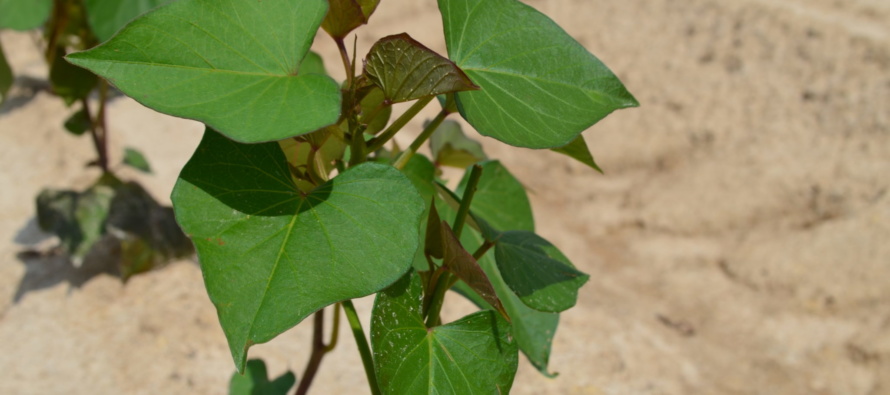Two Frequently Asked Questions Concerning Sweetpotatoes and Auxin Herbicides

Related Articles
- Calcium and Magnesium For Mississippi Crops 0
- March 11 Precision Agriculture Workshop 0
- Ground Speed Affects Spray Droplet Deposition 0
Latest Tweets
With increasing utilization of auxin herbicide-tolerant cotton and soybeans, sweetpotato growers have concerns about drift and off-target movement of dicamba and 2,4-D applications into commercial sweetpotato fields. In this blog entry I answer two of the most common questions I have received.
“What does auxin herbicide injury on sweetpotato look like?”
When injury symptoms are present, they will nearly always include epinasty- petioles and sometimes entire stems bend and twist (Figures 1-2).
Figure 1. Healthy sweetpotato plants approximately 2 weeks after transplanting.
Figure 2. Sweetpotato plants treated with 1/8X rate of dicamba.
Additional symptoms may include distorted leaves. Leaf margins may take on a “puckered” appeared and roll or cup downward (Figure 3).
Figure 3. Sweetpotato leaves exposed to 2,4-D.
“What kind of yield loss can be expected if drift occurs?”
Limited studies have been conducted to investigate the sweetpotato response to these herbicides. The most recent work was conducted in Louisiana by Batts (2015) who investigated tank contamination and spray drift rates of 2,4-D, dicamba, glyphosate, and combinations of 2,4-D plus glyphosate, and dicamba plus glyphosate applied at 10 or 30 days after transplanting. Here is what the researchers found:
Dicamba and glyphosate plus dicamba at 1/10x reduced storage root number 42% and total yield was reduced 36 to 91%. Dicamba alone at 1/500x still reduced sweetpotato yield compared to a non-treated check.
2,4-D at 1/100X, 1/250X, and 1/1,000X reduced storage root number by 22% when applied 10 days after transplanting. A 1/10X rate reduced storage root number by 35%. Total yield was reduced 60% when 2,4-D was applied at 1/10X 30 days after transplanting.
While preparing the herbicide chapter of the most recent sweetpotato compendium (Clark et al. 2013), I applied numerous herbicides to sweetpotatoes after canopy closure to observe and document symptomology. Roots of sweetpotatoes exposed to dicamba exhibited cracked and scaly skin (Figure 4). Roots with this type of injury have little value even in processing markets.
Figure 4. Sweetpotato storage roots exposed to dicamba after canopy closure.
Literature cited:
Batts, TM (2015) Impact of reduced rates of hormonal herbicides on sweetpotato (Ipomoea batatas Lam.) growth and development. MS Thesis: Louisiana State University. 57 p.
Clark, CA, DM Ferrin, TP Smith, and GJ Holmes, eds. (2013) Compendium of Sweetpotato Diseases, Pests, and Disorders 2nd Edition. APS Press: St. Paul, MN.










Let me tell You a sad story ! There are no comments yet, but You can be first one to comment this article.
Write a comment